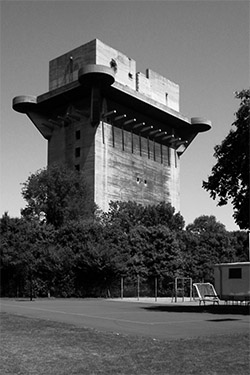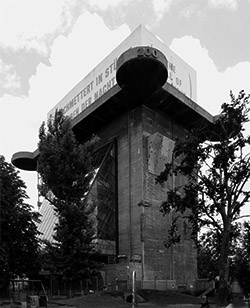
In Vienna, the anti-aircraft towers from the war still stand today, and there is a museum in them
 |
Six concrete towers were built from 1942 to 1945. They were constructed in pairs. One held radar and measuring equipment, while the other housed anti-aircraft guns, connected by an underground corridor.
The tower pairs form a triangle around St. Stephen's Cathedral. Although the towers vary in height, their tops are at the same elevation. The tallest colossus has 13 floors. They had their own systems for energy, drinking water, and ventilation. They also hid anti-aircraft shelters, a hospital, a factory hall, and a command center, making them some of the largest bunker structures in the world.
After the war, the Allies wanted to blow them up. However, since they were situated among other buildings, they abandoned the plan. Suggestions were made to convert the windowless towers into residential or office buildings. Most authors attempted to conceal the appearance and purpose of the structures. Over time, however, the concrete giants began to be viewed as witnesses of an infamous history and gained monument protection. Thus, they cannot be demolished or significantly altered.
 |
The colossus has not changed much in appearance. It has received only a glass extension. According to curator Marcello La Speranza, this does not erase its history and continues to show a "memorial to the bombing raids" on Vienna.
Inside the museum, however, visitors would not recognize that they are in a bunker. They can recall this by viewing an exhibition where period materials are complemented by sparse furniture, gas masks, a suitcase with items for the shelter, and other objects. Visitors can also listen to original raid announcements. A female voice speaks of "40 heavy cars." This meant that 40 bombers were approaching Vienna. The cutting of the entrance to the stairs leading to the exhibition took two weeks, according to the guide. The concrete walls measure more than two meters.
 |
Ideas for how the colossi could be used after the war were already planned during their construction. The Nazis later wanted to clad them in marble and decorate them with reliefs to remind future generations of the glory of the thousand-year empire. However, according to some experts, it was likely clear from the very beginning that the objects had psychological significance and were intended to serve as a giant monument.
"These towers probably had more symbolic meaning than actual military significance. It is now known that they reflected less than 0.8 percent of air attacks," said Itai Margula from the Academy of Fine Arts in Vienna. He added that the radar systems on both connected giants did not function effectively, and the anti-aircraft guns couldn't shoot high enough to hit the bombers. Additionally, the objects were originally supposed to be located far from the city center. However, Hitler allegedly decided on their placement in the center to have them visible to everyone.
Anti-aircraft towers were also built in German cities. Six were erected in Berlin and four in Hamburg. Most of them were blown up by the Allies after the war.
While the House of the Sea can be visited 365 days a year, those interested in visiting the modern art gallery in Arenberg Park must wait until May, as the tower is closed during the winter.
The English translation is powered by AI tool. Switch to Czech to view the original text source.
1 comment
add comment
Subject
Author
Date
Díky za info
Jitka Floriánová
05.12.10 07:45
show all comments












